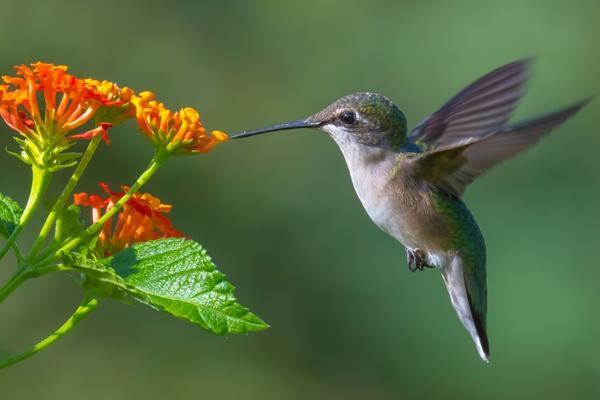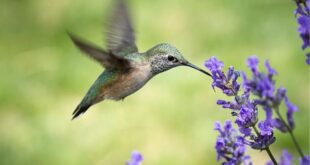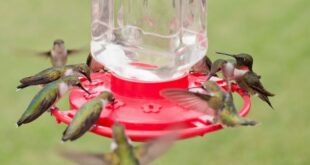Most people know that hummingbirds are amazing creatures. They can fly backward and upside down, and they have the ability to hover in mid-air. What many people don’t know, however, is that these tiny birds migrate south every winter. So when do hummingbirds migrate south? And why do they do it? Let’s take a closer look at this fascinating phenomenon.
Do hummingbirds migrate?

Hummingbirds are among the most fascinating birds in the world. Tiny and delicate, they are known for their iridescent feathers and their ability to hover in mid-air. Hummingbirds are also notable for their long migrations.
Every year, these tiny birds travel hundreds or even thousands of miles, following the flowers as they bloom across the country. While most hummingbirds migrate alone, there are some species that travel in large flocks.During their migration, hummingbirds face many dangers.
They must dodge predators, navigate hostile weather conditions, and avoid exhaustion. Despite the challenges, hummingbirds continue to migrate every year, ensuring the survival of their species.
When do hummingbirds migrate?
Every year, millions of birds undertake grueling journeys to reach their winter homes. For some species, this may mean flying nonstop for days or even weeks. But among all migrating birds, none are more remarkable than hummingbirds. These tiny creatures can fly up to 500 miles in a single day, and their journey takes them from the cold winters of Canada all the way to the tropical rainforests of South America.
But when exactly do these amazing creatures make the journey south? The answer depends on the species. Some hummingbirds migrate as early as July, while others may not begin their journey until November. For most hummingbirds, though, the migration period falls somewhere in between these two extremes. So the next time you see one of these tiny birds zipping around your garden, take a moment to appreciate the incredible journey it has taken to get there.
What month do hummingbirds migrate south?

Each fall, as the days grow shorter and the temperatures begin to drop, hummingbirds across North America begin their journey south. Depending on the species, they may fly to Central America, Mexico, or even as far as South America.
The exact timing of their migration varies depending on the weather, but most hummingbirds begin their southward journey in September or October. While some hummingbirds may stay in one location for the entire winter, others may make several stops along the way, depending on the availability of food.
No matter where they end up, however, all hummingbirds will return to their breeding grounds in the spring. So if you’re ever lucky enough to spot a hummingbird in your garden, enjoy it while you can – they won’t be sticking around for long!
When do hummingbirds migrate north?
Most hummingbirds migrate north in the spring, when the weather becomes warm and flower blossoms begin to appear. However, there are a few species of hummingbird that migrate south in the fall, when food becomes scarce. Some hummingbirds even migrate back and forth between the two regions every year.
Regardless of which direction they migrate, hummingbirds rely on a steady supply of nectar to power their long journey. To ensure that they have enough to eat, many hummingbirds will double their body weight before beginning their migration. Once they reach their destination, they will spend the summer feeding and raising their young before making the journey back again.
How do hummingbirds migrate?

Hummingbirds migrate in a variety of ways, from short hops to long-distance flights that span thousands of miles. During migration, hummingbirds take advantage of favorable winds and thermals (rising columns of warm air) to conserve energy and fly more efficiently. Some species are capable of flying at night when conditions are cooler, aiding them in their journey.
Most species of hummingbirds will travel alone or in small flocks, but some may join larger groups of birds during migration. For example, the ruby-throated hummingbird (Archilochus colubris) and other species often form large flocks before crossing the Gulf of Mexico—the longest open-water segment of their journey.
In addition to flying, hummingbirds may take breaks along the way to rest and feed, especially during long flights. During these pauses, they will often land on trees, shrubs, or other vegetation in order to perch and refuel. Depending on the species, some hummingbirds may make a brief stopover at a single location, while others may make multiple stops along their migratory route.
How do hummingbirds know when to migrate?
Hummingbirds instinctively know when it’s time to migrate south. Nature is an amazing thing, and hummingbirds are no exception! Their bodies tell them that they need to move in order to survive the winter months.
They can sense changes in the weather, temperature, day length, and food availability that all point towards migration season. As the weather gets colder and food sources become harder to find, hummingbirds know that it’s time to move on.
Why do some hummingbirds not migrate?
Not all hummingbirds migrate south for the winter. Some species of hummingbirds have adapted to their environment, allowing them to stay in one place year-round and survive on local resources. These “non-migratory” hummingbirds are found in tropical climates such as Florida and Hawaii, as well as areas with mild winters like California, Arizona, and parts of New Mexico.
In these areas, temperate climates make it possible for non-migratory hummingbirds to survive the winter without having to migrate south. In places where temperatures drop below freezing or snow accumulates during the winter months, however, non-migratory hummingbirds are unlikely to survive.
Do hummingbirds migrate in flocks?

Hummingbirds are one of the most interesting bird species in North America. Though they are among the smallest birds, they are also some of the most proficient flyers, capable of flying up to 60 miles per hour. They are also well-known for their migratory patterns, which see them travel great distances between their breeding and wintering grounds.
However, one question that often arises about hummingbirds is whether they migrate in flocks. The answer is a bit complicated. While hummingbirds do not typically fly in large groups, they will often congregate in areas where there is an abundance of food. As a result, it is not uncommon to see dozens or even hundreds of hummingbirds gathered in one place.
However, once the food source is depleted, the birds will disperse and continue on their migration solo. So while hummingbirds may temporarily form flocks during their migration, they do not typically travel in groups.
How does weather affect hummingbird migration?
Migration is a crucial part of the hummingbird life cycle, but it can be a dangerous journey. These tiny birds must cross vast distances, often in difficult weather conditions. strong winds can make it hard for them to fly, and cold temperatures can slow their metabolism, making it harder for them to find food.
Additionally, bad weather can cause storms that can disorient the birds and prevent them from reaching their destination. As a result, weather plays a significant role in the success of hummingbird migration. Fortunately, these intrepid creatures are well-adapted to deal with adverse conditions, and they often arrive at their destination safely despite the challenges.
How far do Rufous hummingbirds migrate?
Rufous hummingbirds are the most migratory species of all North American hummers. They have one of the longest migrations of any bird in the world, flying up to 14,000 miles each year! Each spring they migrate from Mexico and Central America to their breeding grounds in western North America as far north as Alaska. In fall, they migrate south again to winter in Mexico and Central America.
Rufous hummingbirds typically cover this distance in multiple flights of a few hundred miles, rather than one long flight. During their migration, they may pause for several days or weeks along the way to rest and refuel on nectar and insects.
At times, Rufous hummingbirds may be seen as far east as the Mississippi River or even Florida. However, this is usually due to a phenomenon known as “vagrancy” which is when birds wander into areas they wouldn’t normally visit.
Rufous are not the only hummers that migrate south for the winter. Many other species of hummingbirds, such as the Broad-tailed, Black-chinned and Calliope, also undertake long migrations from North America to Mexico or South America. In the United States, hummingbird migration peaks in late summer and early fall, but there are regional variations depending on where you live.
In addition to their long-distance migrations, hummingbirds also undertake shorter “local” migrations. These birds may move from high mountain areas to lower elevations in the winter or from deserts to nearby cities and towns that offer more dependable food sources during lean times.
It’s amazing to think that such a tiny bird can make such a long journey every year. But we can thank their incredible endurance and adaptability for being able to do this. Hummingbirds are truly one of nature’s marvels!
By understanding the migratory patterns of hummingbirds, birders can be better prepared when they come across these lovely birds near their homes.
How long does it take for hummingbirds to migrate?

The exact amount of time it takes for hummingbirds to migrate varies depending on the individual bird and its destination.
In general, a migration trip can take anywhere from around two weeks to several months, with some species migrating over 2,000 miles. The time frame of migration also depends on the weather conditions during their journey. If the climate is favorable, hummingbirds may migrate more quickly and easily.
Do hummingbirds come back to the same area every year?
That’s a question many people ask when thinking about hummingbird migration. The answer is yes and no. While some species of hummingbirds may return to the same area each year, others might migrate farther south or over a different route.
Most North American hummingbirds migrate south in the fall, typically leaving their northern homes between August and October. Hummingbirds will fly thousands of miles to their wintering grounds in Mexico, Central America, or the Caribbean.
As they make this long journey, they must build up energy reserves in order to survive the cold temperatures and lack of food on their way. To accomplish this, they feed heavily on nectar-rich flowers and insects before leaving on their journey.
While the timing of migration varies depending on the region, most hummingbirds that migrate south spend the winter in Mexico and Central America. The main reason for this is because these regions offer warmer temperatures and more food sources during the cold winter months. During their stay, they will feed mostly on nectar from flowers, insects, and small lizards.
Some hummingbirds that migrate south will also make stopovers at various points during their journey, such as in Texas and Arizona. These stopover areas provide the birds with much needed rest and food sources before continuing on their trip.
Hummingbird migration is a remarkable event to witness. Watching these tiny birds take flight as they prepare for the long journey ahead is a sight to behold. For those who have the opportunity, consider taking part in one of the many hummingbird migrations events across North America. You may even be able to witness a mass departure of thousands of hummingbirds from their summer homes.
Overall, understanding when and why hummingbirds migrate south is essential to ensuring their safe and successful journey. By providing food sources, rest stops, and plenty of water along the way, we can help ensure that these delicate creatures make it to their winter homes safely each year.
Conclusion
When do hummingbirds migrate south? Well, it depends on where you live and what type of hummingbird is present. In general, most hummingbirds migrate to warmer climates during the fall season in order to escape from cold weather or food shortages in their northern homes. This migration can take place over hundreds or even thousands of miles and can take several weeks or even months to complete.
While some hummingbirds may only migrate as far south as California or Mexico, other species may travel much farther south – all the way to Central or South America! So if you want to catch a glimpse of these amazing birds, make sure that you keep an eye out during the fall season in your area!
FAQs
How can I help migrate hummingbirds?
Every year, hummingbirds migrate thousands of miles to reach their breeding grounds. The journey is an incredible feat of endurance, and many birds do not survive the trip. However, there are several things that landowners can do to help migrating hummingbirds. One is to plant native flowers that provide nectar for the birds.
Another is to avoid using pesticides, as they can poison the birds. Finally, it is important to leave some areas of land undeveloped, as this provides critical habitat for the birds. By taking these simple steps, landowners can help ensure that hummingbirds have a safe place to rest and refuel during their long journey.
How do hummingbirds fly so far?
Hummingbirds are renowned for their aerial prowess, but how do they manage to fly such great distances? The key lies in their unique physiology. Unlike other birds, hummingbirds have a higher proportion of breast muscle, which gives them the power they need for sustained flight. In addition, their wings are specially adapted for maximum efficiency.
The leading edge of the wing is concave, which helps to create lift, and the trailing edge is deeply indented, which allows air to flow smoothly over the wing surface. As a result of these adaptations, hummingbirds can flap their wings up to 80 times per second, giving them the ability to climb, hover, and even fly backwards.
Thanks to these extraordinary abilities, hummingbirds are able to migrate long distances and take advantage of food sources that would be inaccessible to other birds.
When will the hummingbirds arrive?
Hummingbirds are one of the most beloved backyard birds, known for their cheerful chirps and fascinating aerial feats. But when do these tiny creatures arrive in North America? According to The Old Farmer’s Almanac, hummingbirds begin to migrate north from Central America in late February or early March. Migration patterns vary from year to year depending on weather conditions, but most hummingbirds reach the United States by mid-April. So if you’re hoping to catch a glimpse of these amazing birds, keep your eyes peeled in the coming weeks!
 Access Birds Let’s Make The World A Happier, Healthier Place For Birds.
Access Birds Let’s Make The World A Happier, Healthier Place For Birds.




